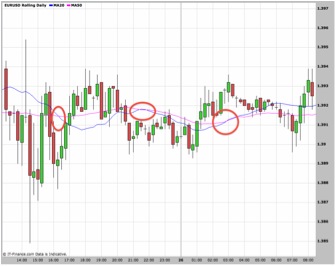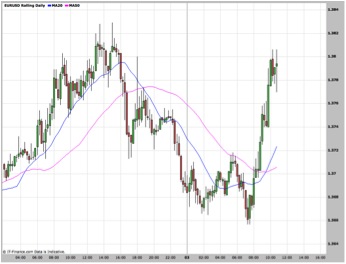The global markets are in a very uncomfortable place.
They jump on every rumour leaked from the Eurozone, be it what George Papandreou ate for breakfast, the colour of Nicolas Sarkozy’s socks, or the smirk on Angela Merkel’s lips.
If you’ve grown tired of trying to second-guess how the markets will react, there is an alternative.
That alternative is to seek refuge in a successful trading strategy – one that trades what it sees in the markets, and not what it thinks politicians will do next.
But what constitutes a successful strategy?
Sure, we expect it to make money over the long term, but if we’re aiming for that profitable goal, we need to know what tools are going to get us there…
How to build a trading strategy
If you’ve ever tried to build a trading strategy, you’ll have some idea of how it generally works…
You develop a set of rules.
Let’s say that it’s something dead simple, like a double moving average crossover, with a 20- and a 50-period simple moving average. You buy when the 20 line crosses above the 50 line; you sell when the 50 line crosses above the 20 line.

Seems to be going well.
But, you are plagued by false signals …

So you adjust your moving averages… you try 17sma and 45sma.
Problems with false signals persist…
So you try exponential moving averages… and so on… and so on…
Eventually you run out of things to change, and discard your trading strategy.
Throwing out the baby
What went wrong?
Was the strategy flawed?
I think not.
In my opinion, too many great trading ideas (and a good deal of trading research) are cast aside for no good reason.
There’s nothing wrong with a double moving average crossover strategy – I know enough people who make good money from these kinds of set-ups.
What’s gone wrong here is that we’ve mistaken what this is – it’s a set-up. It is not a complete strategy.
A set-up is an important part of a trading strategy, but it’s only part of it. A successful strategy needs a set-up, an entry, and an exit.
I’ll write more about exit strategies another day. Today I want to concentrate on building a successful entry.
Entry is everything
Creating a set-up can be the fun part of creating a strategy – it’s the “big picture” part that alerts us to a trading opportunity. But how we react when we get that all-important alert will make the difference between success and failure.
Our entry should be designed to give us confirmation that what we see in the set-up is valid.
If our set-up tells us there is a buying opportunity – our entry criteria should be telling us “yes, the market is moving up”. If our set-up is signaling a sell trade – our entry criteria will be confirming that downward movement.
So, if we follow our example above, and our 20 SMA has just dropped below the 50 SMA, telling us that we have a set-up for a sell trade.
But before we enter that trade, we need to meet our entry criteria…
This criteria might be something like “sell one pip below the current candlestick’s low”.
If you check the chart above, which shows four false signals – adding this very simple entry criteria would have cut out three of those four losing trades.
Of course, adding extra criteria to your trade adds to the chances of you missing out on big moves if all your conditions haven’t been met. It’s a balancing act, and you can build in the criteria that suit the kind of success rate you demand of your trading.
If you’re a cautious trader, you might demand that more than one criterion is met.
If you’re more adventurous, and hate to miss out on any move – you might opt for a couple of criteria, and enter a trade if just one of those is met. That way, you can give yourself the best chance of getting in on any successful trade – and not miss out on market moves.
Building a comprehensive picture
So, next time you’re considering changing your set up – perhaps thinking of adjusting the criteria on your Stochastics… or shifting your moving average by a couple of periods…
Chances are that you’re blaming the wrong thing.
By instead tweaking your entry criteria, you have the power to filter out losing trades. Of course, however perfect your system, there will always be times when the markets punish us, but that’s what makes trading so interesting, and why we apply careful money management.
